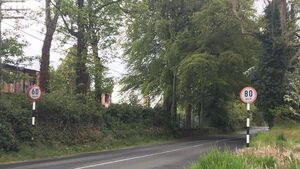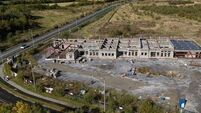Speed limit reduction will come into effect in Laois in early February

Speed limits in 80kph zones will be reduced to 60kph from 7 February File image
SPEED limits will drop from 80kph to 60kph on hundreds of kilometres of Laois roads in early February.
The reduction will be implemented on almost 700km of roadway in the Graiguecullen-Portarlington Municipal District alone, a council meeting was told.
Laois County Council is preparing to replace 80kph speed limit signs with 60kph signs on routes across the county, as part of a new reduction that will come into effect nationwide on 7 February.
The speed limit decrease is part of a national initiative directed by the Department of Transport, in an effort to reduce road deaths by lowering speed limits.
At a recent meeting of Graiguecullen-Portarlington Municipal District, senior engineer Philip McVeigh confirmed that 80kph zones would become 60kph zones on local roads on 7 February, affecting almost 700km of roads in the district. Similar reductions will be implemented in the Portlaoise and Borris-in-Ossory Municipal Districts.
The 80kph to 60kph decrease is the first in a series of speed limit reductions set to be introduced this year. It will be followed by a reduction from 100kph to 80kph on national secondary roads and from 50kph to 30kph in built-up areas. These phases are expected to begin from June, but a definite date has yet to be announced.
Mr McVeigh told the municipal meeting that 7 February is the date the council has been given by the Department of Transport for the installation of all new 60kph signs in the county. A date is still awaited for subsequent phases and road signage will be erected prior to all speed limit changes.
Independent councillor Aisling Moran asked: “Does that mean we can have ramps on roads where we couldn’t get ramps before, because they were 80kph zones?” The engineer confirmed that ramps could be installed in 60kph zones and lower.
Cllr Moran recalled that her previous requests for cycle lanes on a number of local roads were turned down, because they were in 80kph zones. She wondered whether such requests would be accepted following the reduction to 60kph.
Mr McVeigh replied that anything that currently applies to a 60kph zone will apply to the new areas reduced from 80kph to 60kph.
A national public information campaign will begin prior to the local road phase of the speed limit reduction in February.
The speed reductions are part of the government’s Road Safety Strategy 2021-2030, which aims to reduce the number of deaths and serious injuries on Irish roads by 50% by 2030.
Speed limits were reviewed by a working group made up of representatives from the Department of Transport, An Garda Síochána, the Road Safety Authority (RSA), Transport Infrastructure Ireland (TII), the National Transport Authority (NTA) and the Local Government Management Agency (LGMA). When the review was published in September 2023, the department said in a statement: ‘The review highlighted that protecting vulnerable road users must be a key focus when setting speed limits. For example, the risk of being killed is much greater for collisions between a car and a vulnerable road user at 50kph, when compared with the same type of collision at 30kph.’ The review recommended changes to default speed limits on three classes of roads: ‘Rural local roads to reduce from 80kph to 60kph; national secondary roads to reduce from 100kph to 80kph and roads in built-up areas to reduce from 50kph to 30kph.’ The changes were brought into effect by the .





